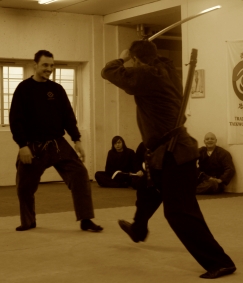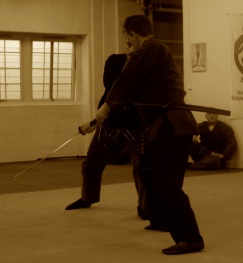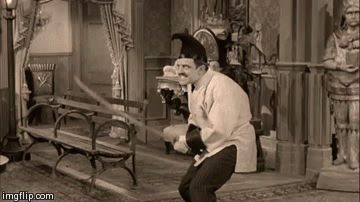Muto No Kyojitsu (無闘の虚実)
From The Magick & The Mundane » Bujinkan by Shawn Gray
Greetings!
Back after a _long_ hiatus, with a brief post to explain the theme for two Bujinkan seminars I’ll be doing in January – Vancouver (Jan 4/5) and Houston (Jan 11/12). Maybe writing this will also spur me on to go back and pick up Path to the Heart of the Flower, a story that I began to write in early 2012. I also have some other ideas that I’d like to write about, but it’s hard to find the time. Thanks to those of you who keep asking me to write, as it helps to keep it on my mind and pushes it a little higher up on the priority list. :)
When the seminar hosts asked me about a theme for training, I thought back over some important things that Hatsumi Sensei focused on in Hombu Dojo Keiko this past year. The official theme of training as announced at the beginning of the year was Ken (劔), the straight, double-edged sword, but as often happens with Sensei, the theme had completely morphed by the second half of the year. In fact, we rarely used Ken at all in training for most of the whole second half of the year. I’m not sure the reason, but we somehow found ourselves doing a lot of Muto Dori (無刀捕り) work against both regular Katana (刀) and Bo (棒). Sensei continued to stress the central importance of Muto Dori throughout the end of the year, with much mention of the role of Kyojitsu (虚実) within Muto Dori movement.
I’ve always liked to cheer for the underdog. I like strategies and techniques that enable a physically weaker person to even the odds against a physically stronger person. That’s why I like Gyokko Ryu movement. Sensei emphasized the importance of this kind of movement a lot early in the year, and especially at the Bujinkan Women’s Taikai in March. In fact, Sensei stressed that women’s self-defense was the last and greatest thing that he learned from Takamatsu Sensei, stating that this idea reflects the pinnacle of Taijutsu training. The use of weakness to defeat strength.
This idea is highlighted even further when the opponent has a weapon and the defender is unarmed. Facing a physically bigger, stronger opponent can be daunting enough as it is, let alone an opponent who’s trying to take your head off with a meter-long razor blade. Learning to deal with this type of situation is challenging for even the most skilled martial artists, which is precisely why Muto Dori should be practised with proper Kihon (基本, fundamentals / basics), practised well, and practised often. The lessons learned can be applied not only to classical scenarios with swords, but also to modern situations where an opponent might have a knife, a stick, or virtually any other kind of weapon. Or no weapon at all – Muto Dori principles can just as easily be applied against unarmed attacks.
That brings me to the concept of Kyojitsu (虚実). That’s Jitsu (“fact, truth”) with an ‘i’, not Jutsu (“art, technique”) with a ‘u’. Different words, different meanings, different spellings. The word Kyojitsu is made simply by putting the Kanji for “lie” or “falsehood” next to the Kanji for “truth” or “fact”. False-fact. Lie-truth. How does this make any sense? This is a great term because the composition of the term itself teaches us about the nature of its meaning. That is, that its nature is illogical. By definition, it doesn’t make sense. It’s not supposed to make sense. Sensei often talks about common sense being of no use in a fight – that one needs to throw away common sense in that situation and adopt un-common sense. Fighting is crazy, and war is insane. Why should one human being want to harm another human being in the first place? Perhaps that’s the actually the root of the issue, but standing around philosophizing about it in an illogical situation will only get you cut down by that meter-long razor blade. There’s a time for thinking, and a time for doing. Standing unarmed in front of a sword-wielding attacker is not a time for thinking. People involved in serious accidents or other life-threatening situations often say that in the midst of the craziness, in the midst of the chaos, it was as if their mind shut off and they went on to auto-pilot. That is, they stopped thinking, and just acted. To many people, even the idea of stop thinking sounds illogical. How do you stop thinking? Not by thinking about stopping. Only by doing it. This concept don’t think, just act is essential to Muto Dori. To do this, of course, requires a lot of practise. Your body needs to know what to do when you put it on auto-pilot, and it learns what to do through repetition, training, and practise. A Gokui (極意, mystery / secret) of Muto Dori teaches this importance of doing:
振りかざす太刀の下こそ地獄なれ
一と足すすめ先は極楽Furi kazasu tachi no shita koso jigoku nare
Ichi to ashi susume saki wa gokurakuHell under the upraised sword,
one step forward is paradise
So let me see, this angry guy is brandishing a meter-long razor blade at me, and you want me to … what? Stepping in might sound illogical (not to mention dangerous). On the spot, it might seem to make more sense to turn and run away (when in fact turning your back could be even more dangerous). This daring to step in, this stepping forward instead of away, this doing, is one example of Kyojitsu.
In thinking about these ideas, I realized that there’s a Kanji meaning “fighting” that is also pronounced “To”: 闘. One can therefore write Muto the regular way (無刀), which means “without a sword”, and one can also write Muto as 無闘, “without fighting”. (Wouldn’t you know it – the day after I realized this about these Kanji, I discovered the same use of it in Sensei’s latest book, Ninja Taizen.) This kind of wordplay is another example of Kyojitsu – first the word means one thing, and then it means something else. Or, you think it means one thing, when in reality it means another.
So this is the type of concept that we’re going to be working with at the two seminars I’ll be teaching in January – “Muto Dori – Muto No Kyojitsu” (無刀捕り:無闘の虚実). I guess you could also call it, “Head-scratching non-combative unarmed responses to armed attacks” if you like. :-) I hope this short article has helped to shed some light on the ideas behind the theme. If you’ll be in Vancouver or Houston during the dates listed above and would like to attend, please contact me on Facebook or by email at [email protected], or contact the seminar host directly via the Facebook page.
無刀捕りの極意は無闘捕りの得。
体術の極意は平和の道なりと知る。The secret of Muto Dori is achieving a state of non-combat.
The secret of Taijutsu is to know the path of peace.
~ Hatsumi Masaaki Soke ~







